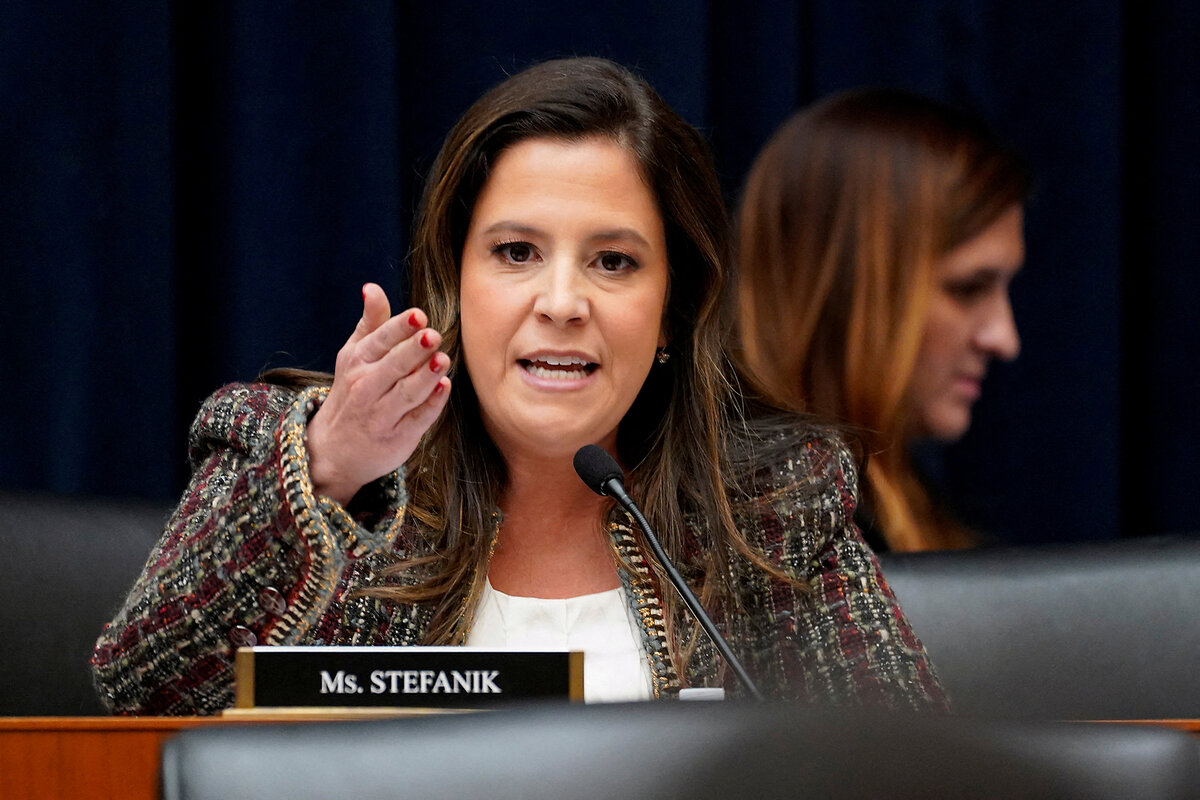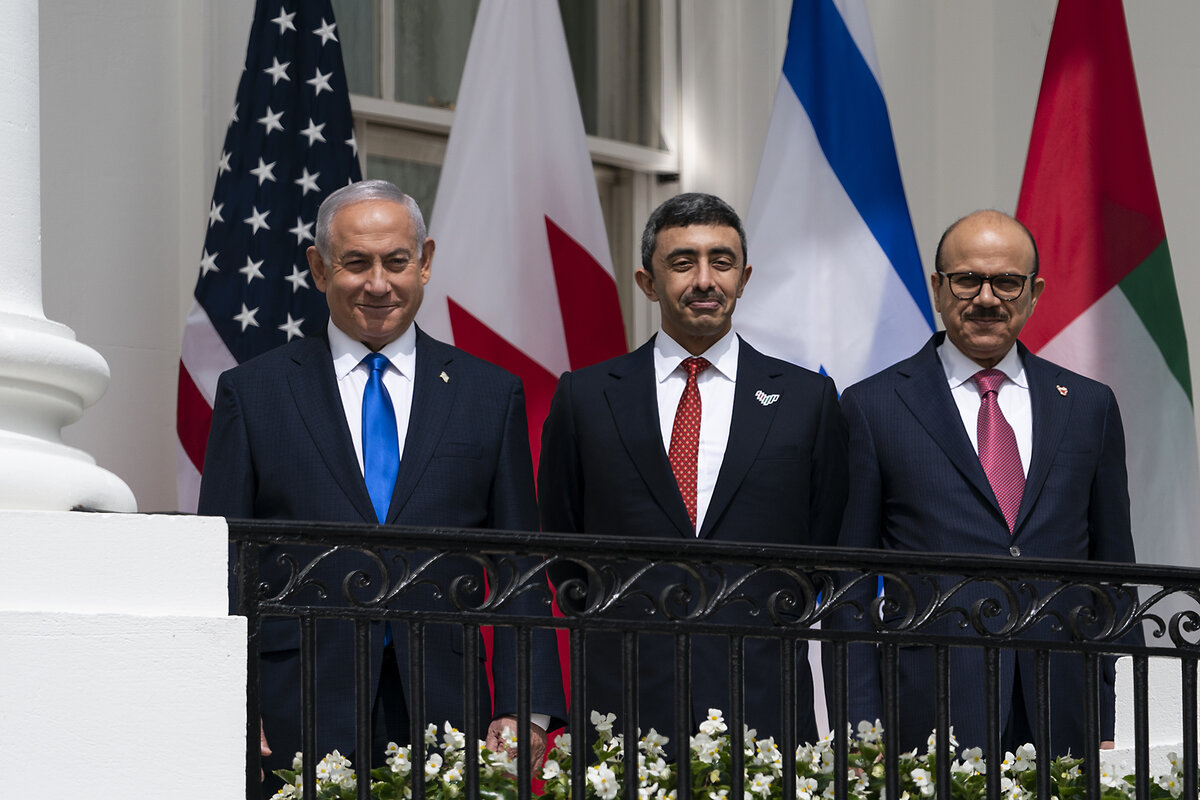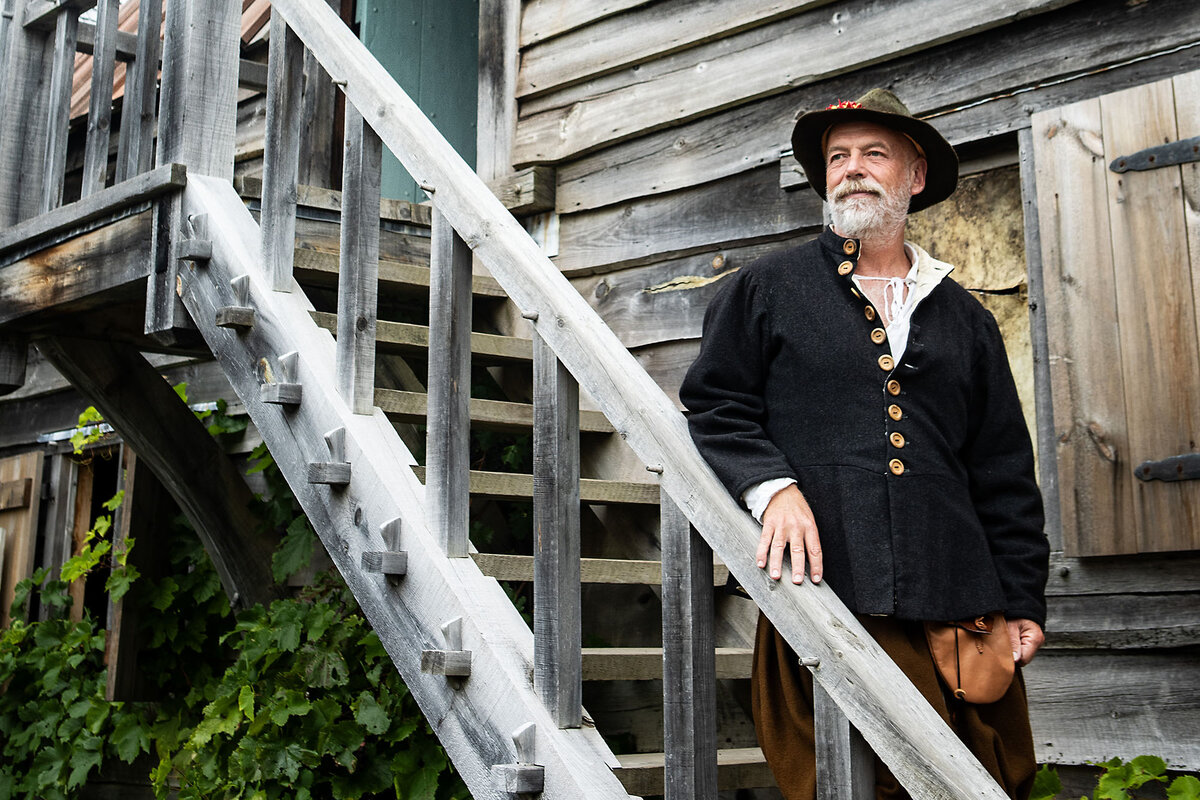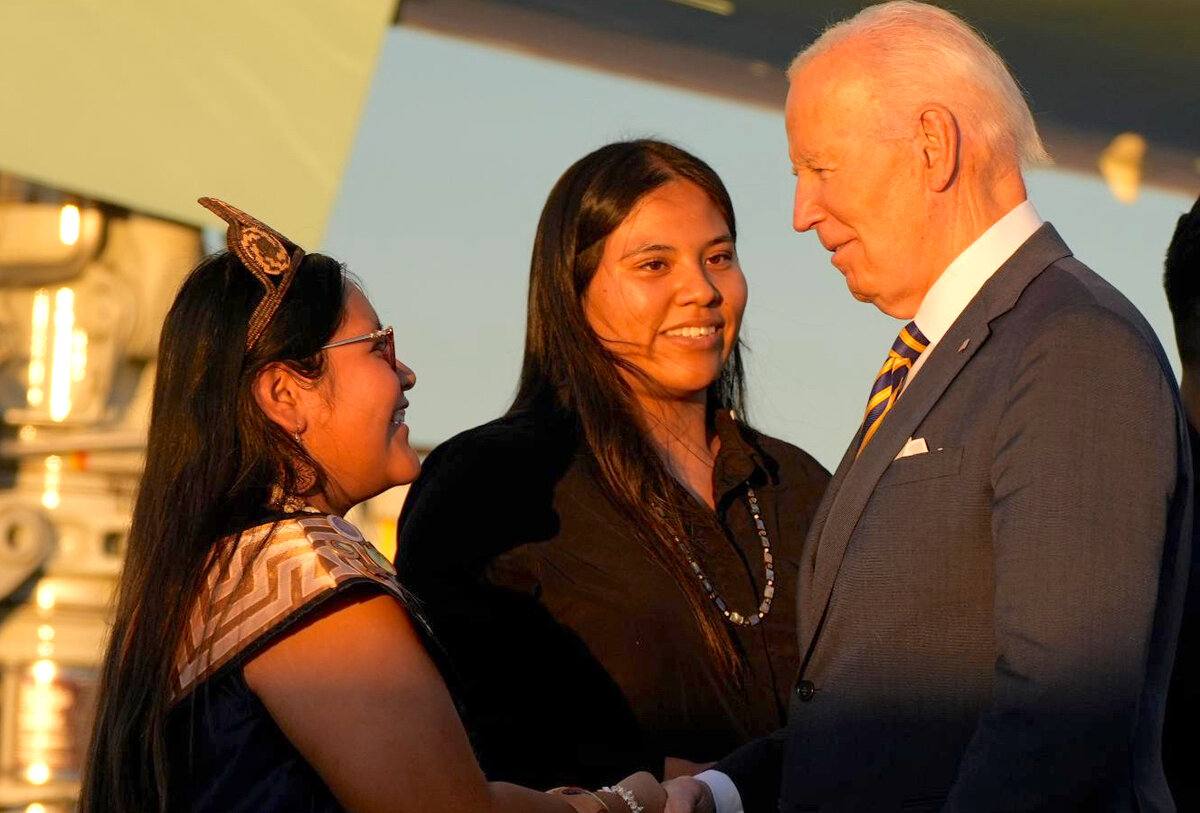- Quick Read
- Deep Read ( 4 Min. )

Why is Christian Science in our name?
Our name is about honesty. The Monitor is owned by The Christian Science Church, and we’ve always been transparent about that.
The Church publishes the Monitor because it sees good journalism as vital to progress in the world. Since 1908, we’ve aimed “to injure no man, but to bless all mankind,” as our founder, Mary Baker Eddy, put it.
Here, you’ll find award-winning journalism not driven by commercial influences – a news organization that takes seriously its mission to uplift the world by seeking solutions and finding reasons for credible hope.
Explore values journalism About usIn Today’s Issue
- Israel enjoys upper hand as ceasefire signals Hezbollah’s limits
- Today’s news briefs
- Trump’s Mideast team: A familiar look for a transformed region
- In Canada, too, people remember a feast with settlers and Indigenous people
- Russian TV calls Tulsi Gabbard ‘our girlfriend.’ Can she keep US secrets?
- How ‘History Alice’ is getting Gen Z to learn about the past
- Five-star ‘Flow’ and chatty ‘Moana 2’ offer eye-widening animated delights
Monitor Daily Podcast
- Follow us:
- Apple Podcasts
- Spotify
- RSS Feed
- Download
TODAY’S INTRO
A harvest season in any season
 Mark Sappenfield
Mark Sappenfield
Today, Sara Miller Llana writes about the earliest Canadian harvest traditions, which evolved into Thanksgiving. Melanie Stetson Freeman’s photos add a sumptuous touch. There is an Order of Good Cheer, beaver tails seared over a roaring hearth, and the hush of crickets going silent at the start of autumn.
But under it all is Tpi’tnewey. For the Mi’kmaq, an Indigenous people in eastern Canada, Tpi’tnewey is intertwined with the harvest season. It is the idea of giving generously, of doing good. This comes from an understanding of the interconnection of all peoples, Sara writes, and so beautifully points to the greater harvest that comes in any season when humility and unselfishness are in abundance.
Share this article
Link copied.

Help fund Monitor journalism for $11/ month
Already a subscriber? Login

Monitor journalism changes lives because we open that too-small box that most people think they live in. We believe news can and should expand a sense of identity and possibility beyond narrow conventional expectations.
Our work isn't possible without your support.
Israel enjoys upper hand as ceasefire signals Hezbollah’s limits
Hezbollah has emerged from its 13-month war with Israel leaderless and weak, no longer the powerful regional force that Iran has depended on. Will Israel seek to take advantage of Tehran’s new vulnerability?

-
Dina Kraft Special correspondent
A ceasefire came into force in Lebanon before dawn on Wednesday, as Israel and the Shiite militia Hezbollah laid down their arms, after more than a year of hostilities.
The U.S.-brokered 60-day truce prompted thousands of Lebanese to clog southbound roads toward the areas hit heaviest by the fighting, as they returned to what remained of their homes.
Under the terms of the ceasefire, Hezbollah troops must pull back behind the Litani River, which runs about 30 kilometers (18 miles) north of the border, and Israeli forces must withdraw fully from southern Lebanon.
A reported side deal allows them to strike at Hezbollah, however, in consultation with Washington, if Israel detects a violation of the ceasefire terms.
The war has devastated Lebanon – over 138,000 people died, and Israeli airstrikes destroyed swaths of Beirut – and Hezbollah is reeling from the loss of its top echelon of leaders. Once the strongest element in Iran’s array of regional allies, it has lost much of its deterrent power.
That leaves Iran weaker, and Israeli Prime Minister Benjamin Netanyahu boasting that his country is “changing the face of the Middle East.” The question now is whether that ambition will embolden him to attack Iran directly.
Israel enjoys upper hand as ceasefire signals Hezbollah’s limits
Before dawn on Wednesday, Israeli and Hezbollah militia guns fell silent as a U.S.-brokered ceasefire took hold, capping more than 13 months of escalating conflict that has devastated parts of Lebanon and emptied communities on either side of the Israel-Lebanon border.
Celebrations erupted in Lebanon as the 60-day truce took hold. By daybreak, roads heading south to the area hit heaviest by the fighting were clogged with thousands of cars as Lebanese residents returned to what was left of their homes.
On the other side of the border, Israelis were more skeptical. Few of the 60,000 people who had been evacuated from their homes in the face of Hezbollah shelling and missile fire seemed convinced that it was safe to go home. The Israeli army, however, emerged from the war with significant gains.
Israel battered Hezbollah – the strongest of Iran’s regional allies – demonstrating deep intelligence penetration and military prowess. It assassinated the top echelons of Hezbollah’s leadership, destroyed Hezbollah tunnel systems along the border, and claims to have destroyed the bulk of Hezbollah’s arsenal of 150,000 rockets and missiles.
President Joe Biden announced the ceasefire, saying that it is “designed to be a permanent cessation of hostilities,” and that “what is left of Hezbollah” would “not be allowed to threaten the security of Israel again.”

Israel can still attack
The deal requires Hezbollah to withdraw north of Lebanon’s Litani River, about 30 kilometers (18 miles) from the border, and for Israeli forces to withdraw fully from southern Lebanon. Some 5,000 Lebanese army troops, alongside United Nations peacekeepers already on the ground, will monitor the ceasefire.
A reported side agreement allows Israel to strike Hezbollah, in consultation with Washington, if it detects violations of the ceasefire terms. Israel will have to be “very tough” and “disproportionate” in preventing the Shiite militia from rearming and reorganizing near the border, said Yaakov Amidor, a retired general and former national security adviser, during a briefing with reporters.
“After Oct. 7, we learned the lesson,” he said. “We don’t let the other side grow and get stronger.”
Israeli Prime Minister Benjamin Netanyahu said that Hezbollah had been degraded, and was “no longer” the organization that attacked Israel on Oct. 8, 2023, in support of Hamas, which had launched its lethal raid on Israel the day before.
He gave three reasons for the ceasefire: to allow Israel to focus on the “Iran threat”; to give the Israeli military time to regroup after fighting on two fronts; and to isolate Hamas. Hezbollah was obliged to drop its insistence on a ceasefire in Gaza in return for laying down its arms.
The price has been high for Lebanon, where authorities say that more than 3,800 people have been killed – mostly in Israeli bombing raids – and reconstruction costs will be monumental. Hezbollah’s reputation in the country has suffered; many Lebanese, including the militia’s Shiite supporters, are angry at the scale of destruction of a war that many saw as unnecessary.

“It’s critically important that Hezbollah looks after the social welfare needs of their constituents,” says Nicholas Blanford, a Hezbollah expert in Beirut with the Atlantic Council. “That, to my mind, would be a more pressing matter than thinking about rearming.” Already, he says, Hezbollah has made surveys of destruction in Beirut’s southern suburbs, and even issued construction contracts. Providing for people as winter comes will be a key test.
“If these folks are still living in tents on the rubble of their homes in a year’s time, their anger is going to be directed more toward Hezbollah – and Hezbollah can’t afford to have that,” adds Mr. Blanford, author of “Warriors of God: Inside Hezbollah’s Thirty-Year Struggle Against Israel.”
Will Iran be the next Israeli target?
Both sides indulged in a frenzy of violence just before the truce came into force. Israel unleashed some of the heaviest airstrikes of war on Beirut and Hezbollah strongholds in southern and eastern Lebanon, and Hezbollah showed that, however degraded, it could still launch upward of 340 rockets into central Israel in a single day, as it did on Sunday.
But as the war’s dust settles, Israel has wrought fundamental change in the Middle Eastern balance of power.
“This conflict has eroded Iran’s deterrence,” says Mr. Blanford, noting that “mutual deterrence” between Hezbollah and Israel held for 17 years, the longest period of calm on the border since the mid-1960s.
“But the Israelis ended up calling Hezbollah’s and Iran’s bluff,” calculating that Tehran did not want a broader war, he says. What followed was a surge of airstrikes; an attack involving exploding pagers and walkie-talkies, which wounded thousands of Hezbollah fighters; and a wave of assassinations that included Hezbollah’s revered chief Hassan Nasrallah.
“This is going to be a big problem for Iran, because you have a Hezbollah that has been weakened militarily,” says Mr. Blanford.
“The deterrence factor isn’t there anymore,” he adds. That might tempt Israel to attack Iran directly, he suggests. “And if they do that, and if Hezbollah does retaliate, then the Israelis are just going to smash more of Lebanon.”

News Briefs
Today’s news briefs
• China releases U.S. prisoners: Three American citizens imprisoned for years by China have been released and are returning to the United States.
• ICC warrant for Myanmar leader: The International Criminal Court’s chief prosecutor asks judges to issue an arrest warrant for the head of Myanmar’s military junta for crimes committed against the country’s Rohingya Muslim minority.
• South Korea and Ukraine meet: South Korea’s president has met a visiting Ukraine delegation, calling for a joint response to the threat posed by North Korea’s recent dispatch of more than 10,000 troops to support Russia’s war against Ukraine.
• Pakistan capital lockdown ends: Authorities have reopened roads linking Islamabad with the rest of the country, ending a four-day lockdown, after using tear gas and firing into the air to disperse supporters of imprisoned former Prime Minister Imran Khan.
• Snowstorm blankets Seoul: The biggest November snowstorm to hit South Korea’s capital in more than half a century has blanketed the city, with 7.8 to 10 inches in northern areas of Seoul.

Trump’s Mideast team: A familiar look for a transformed region
Donald Trump has put together a Mideast team charged with building on his first term’s successes. But in a region shaken by the war in Gaza, can the deal-making president achieve a historic peace agreement with a team that is heavily pro-Israel?

- Quick Read
- Deep Read ( 6 Min. )
When President-elect Donald Trump named a Middle East team for his second term, it struck some as a bit of déjà vu.
The team includes a real estate mogul with no diplomatic experience, a conservative religious leader who views Israel in messianic terms, and an Israel hawk relishing the prospect of taking on the international community.
“It suggests [Mr. Trump] liked what he got out of the first [Mideast] team,” says Michael Koplow, chief policy officer with the Israel Policy Forum in Washington, “and wants the same, only more and bigger, from this one.”
According to the president-elect’s own pronouncements, the new group will be tasked with ending the region’s wars – within a context of unlimited support for Israel – and with building on the landmark Abraham Accords to attain an agreement normalizing relations between Israel and Saudi Arabia.
Analysts note the team is unlikely to work toward a Palestinian state, and faces a region deeply shaken by the war in Gaza.
“There will not be any normalization with Saudi Arabia until the fighting in Gaza stops,” Mr. Koplow says. “And it won’t happen if the Israelis are getting a green light [from the U.S.] to annex the West Bank or Gaza.”
Trump’s Mideast team: A familiar look for a transformed region

When President-elect Donald Trump named a Middle East team for his second term, it struck some as a bit of déjà vu.
The team includes a real estate mogul with no diplomatic experience, a conservative religious leader who views Israel in messianic terms, and an Israel hawk relishing the prospect of taking on the international community.
“What strikes me about this team is the mirroring” and how “the people he’s chosen are reminiscent of the people he put in the same positions in the first term,” says Michael Koplow, chief policy officer with the Israel Policy Forum in Washington.
“It suggests he liked what he got out of the first team,” he adds, “and wants the same, only more and bigger, from this one.”
Just as Mr. Trump has moved with lightning speed to name his picks for the top positions in the incoming Cabinet, he also lost no time in forming a Middle East team. According to his own pronouncements, the new group will be tasked with ending the region’s wars – within a context of unlimited support for Israel – and building on the landmark Abraham Accords initiated in his first term.
Those accords established diplomatic relations between Israel and some Gulf States, and set off a flurry of economic and cultural exchanges further normalizing the Jewish state’s existence among its Arab neighbors.
The team is also expected to play a key role in paving the way for Mr. Trump to achieve what in his circles is known to be the über dealmaker’s ultimate goal: the Nobel Peace Prize. Though critics of the proposed team note it is unlikely to work toward a Palestinian state.
A quickly changing region
Just what regional context the new team will inherit on Jan. 20 remains to be seen. On Tuesday, Israel and Lebanon accepted a U.S.-brokered deal for a ceasefire with Hezbollah, and it went into effect early Wednesday.
In White House comments, President Joe Biden said the deal would allow his Middle East team to turn back to securing an elusive ceasefire deal in Gaza.
With their eyes instead on January, some staunch Israel supporters are already calling the cast of Middle East aides whom Mr. Trump has assembled the “Dream Team 2.0.” It includes new Middle East envoy Steve Witkoff, a Jewish, Bronx-born real estate developer and Trump golf buddy; former Arkansas governor and Christian evangelist Mike Huckabee as U.S. ambassador to Israel; and hard-line Trump loyalist and Israel defender Rep. Elise Stefanik as U.S. ambassador to the United Nations.

Mr. Witkoff will assume the post filled by Jason Greenblatt, a Trump Organization lawyer and chief adviser on Israel in the first Trump White House. As U.S. ambassador to Israel, Mr. Huckabee, who faces Senate confirmation, would follow Mr. Trump’s lawyer-friend David Friedman.
Ms. Stefanik, the New York Republican who ferociously defended President Trump against House impeachment proceedings, is a frequent U.N. basher. That makes her reminiscent of Mr. Trump’s first U.N. ambassador, Nikki Haley, who famously announced upon her arrival in New York that “there’s a new sheriff in town.”
Perhaps even more than with the original Middle East team, everyone in the new one is known for intense loyalty to President-elect Trump. And much like the original team, no one has anything in the way of traditional diplomatic experience – favoring instead a transactional approach to international relations.
Which appears to be exactly what Mr. Trump was aiming for.
Nominated for secretary of state is Florida Republican Sen. Marco Rubio, who is winning accolades including from Democratic Senate colleagues as highly qualified for the job. But Mr. Rubio, a China hawk, is most likely to be focused on the Asia portfolio and reaching some settlement to the war in Ukraine, some experts say.
In the eyes of some regional analysts, the new Middle East team is already flashing a bright green light to Israel in terms of its pursuit of the war in Gaza and its expansionist policies in the occupied West Bank.
What of the two-state solution?
One of the key innovations of Team 1.0 was to sideline the pursuit of a two-state solution with Palestinians as a requisite part of any regional peace effort. Team 2.0 is likely to follow that approach, only on steroids, some experts say.
“What these appointments tell me is that there is not going to be even the pretense of a negotiated two-state solution” resulting in a Palestinian state alongside Israel, says Khaled Elgindy, director of the program on Palestine and Palestinian-Israeli Affairs at the Middle East Institute in Washington. “These people are hard-core annexationists, very much on board with the messianic extremists of the Israeli government.”
Indeed, Mr. Huckabee has said there is “no such thing” as the Palestinian people, and uses the biblical names “Judea and Samaria” to refer to the West Bank.
Moreover, he says the term “settlements” – used by international institutions to describe what much of the world considers to be illegal outposts on Palestinian lands – is a misnomer for what are simply Israeli towns and cities.
As for the war in Gaza, Mr. Elgindy says the “only way” to end it is to put meaningful pressure on Israel to draw it down.
But “Israel does not intend to leave Gaza, and northern Gaza is not going to be populated by Palestinians any longer,” he says, “and none of that is anything a new Trump administration is going to stop.”

Israel may face pushback from some European countries and others in the international community. But the fiery responses from some ardent Trump supporters to the International Criminal Court’s arrest warrants for Israeli Prime Minister Benjamin Netanyahu and former Defense Minister Yoav Gallant over the war in Gaza suggest how far the new administration will go to protect Israel.
“You can expect a strong response to the anti-Semitic bias of the ICC & UN come January,” Florida Rep. Mike Waltz, Mr. Trump’s pick to be his national security adviser, posted on the social platform X.
Yet even if the new Middle East team resembles the version that once advanced key elements of Mr. Trump’s regional vision, a different context this time around could hinder further progress, some analysts say.
Most important are two major differences from the first Trump term, says Mr. Koplow: This time there is no strong team leader, and the new team starts off with a region deeply shaken by the war in Gaza and the fissures it has left between Israel and its Gulf and Arab neighbors.
“Last time it was understood that Jared Kushner was the centralizing power driving Israeli-Palestinian policy,” Mr. Koplow says of Mr. Trump’s son-in-law. “This team doesn’t have that central driver,” he adds, “so instead there will be competing power centers.”
A Saudi “wild card”?
A plus for the new team is that the Abraham Accords hammered out by Team 1.0 already exist and presumably could be built upon to attain the big prize: an agreement normalizing relations between Israel and Saudi Arabia.
The complicating factor there, however, is the war in Gaza and Israel’s stepped-up operations in the West Bank.
“There will not be any normalization with Saudi Arabia until the fighting in Gaza stops,” Mr. Koplow says, “and it won’t happen if the Israelis are getting a green light [from the U.S.] to annex the West Bank or Gaza.”
Indeed, Saudi Arabia may very well be the “wild card” that could “fundamentally alter Trump’s perspective on the region and how his administration should deal with it,” Mr. Elgindy says.
In other words, the incoming Middle East team may start out by eschewing any pressure on Israel to exit Gaza or accept a two-state solution with Palestinians. But in the end, it may be Mr. Trump’s overriding desire to go down in history as the ultimate dealmaker – and peacemaker – that determines his Middle East team’s direction.

In Canada, too, people remember a feast with settlers and Indigenous people
As Americans gather for Thanksgiving, lesser-known feasts of plenty from Canadian and First Nations history show how gratitude, generosity, and community transcend nationality.

- Quick Read
- Deep Read ( 10 Min. )
-
Melanie Stetson Freeman Staff photographer
Each October, the Mi’kmaw community of Bear River First Nation holds an annual Harvesters’ Gathering, just as their people have for thousands of years.
This year, the annual celebration began the day after Canada’s official Thanksgiving Day. But the Harvesters’ Gathering is not a date on a calendar, says Gerald Gloade, a Mi’kmaw elder and cultural educator.
Instead, it’s the time of year when the tides in the Bay of Fundy are at their peak and when hunted game are large and healthy. “Our fish stocks are at a premium,” Mr. Gloade says. “The bass are in; the salmon are back, and the sea-run trout.”
It’s when the Mi’kmaq listen for the singing of grasshoppers and crickets to stop, he says. It’s a sign of the end of humidity and an indicator to start drying fish for the winter.
“Everything is based on pattern recognition and our connection to the environment,” Mr. Gloade says. “So that’s part of our traditional and ecological knowledge based on where the planet is. That’s when we celebrate.”
The Mi’kmaq recognize modern Thanksgiving, too, as do Indigenous peoples across Canada. But it’s at the Harvesters’ Gathering where they express gratitude.
“It’s about enjoying the year’s bounty,” says Carol Ann Potter, a councilor at Bear River First Nation. “It’s to truly give thanks to land, to mother earth, and to harvesters.”
In Canada, too, people remember a feast with settlers and Indigenous people
Paul Lalonde adjusts his glossy beaver felt hat and welcomes the visitors gathered around a long table to his Order of Good Cheer.
The year, he explains, is 1606, and winter is coming to the banks of the Bay of Fundy. He and his French compatriots barely survived their first winter, unprepared for the harsh conditions that blast through these parts of Canada. They only survived here, in present-day Nova Scotia, with the aid of the Mi’kmaq, the Indigenous people of the area.
That’s why the colonists and Mi’kmaq, he says to the guests watching him bring this history alive, are seated around this table set with pewter plates and cups, about to dig in to a hearty moose muffle stew or perhaps beaver tails seared over a burning hearth.
Mr. Lalonde is an interpretive officer for Parks Canada, and part of his job is to reenact, or “interpret,” events that happened at the Habitation at Port-Royal, a full-scale replica of one of the first European settlements in North America four centuries ago.
Today, in his wood-buttoned black wool doublet, he’s playing the part of a 17th-century French colonist and member of L’Ordre de Bon Temps (the French name), an eating and entertainment club established with a royal charter, like similar orders in France. These rotating feasts are also considered an early Thanksgiving – a holiday most Canadians today experience more as a harvest festival in early fall, but that some historians also trace to the meals in Port-Royal’s common room.


The story shares similarities with the American narrative of Plymouth Rock. The Mi’kmaq, who had lived here for thousands of years, brought the sick and starving colonists both food and their ways of healing.
“We’ve always operated with the understanding that everybody in the world is in relation with one another, whether we admit it or not, and our job is to make those relations good,” says Mercedes Peters, Sharing Our Stories coordinator of the Mi’kmawey Debert Cultural Centre near Truro, Nova Scotia.
But there the similarities mostly end. In the United States, the first Thanksgiving at Plymouth Rock is part of America’s founding lore, a moment that commemorates the birth of a people. In Canada, the holiday is not wrapped up in the colonial narrative, nor is it as fraught with controversy over the reality of colonialist violence against Indigenous people.
The story of Port-Royal’s L’Ordre de Bon Temps, one of Canada’s early Thanksgivings, recalls a moment in history when French colonists and Mi’kmaq chiefs shared a relationship based on respect and reciprocity. That distinct relationship would evolve over time with the descendants of those first French colonists, a people who would come to be called Acadians.
Mr. Lalonde, an Acadian, looks across the Habitation’s common room at his guests here today. “Who do you invite to sit at your table? You invite your friends. You invite the people you trust.”

Shared traditions: Indigenous peoples express gratitude for the harvest
A half hour drive from the Habitation sits the Mi’kmaw community of Bear River First Nation, which is called L’sitkuk in the Mi’kmaw language. Each October, L’sitkuk, at the edge of the fertile Annapolis Valley, Nova Scotia’s breadbasket, holds an annual Harvesters’ Gathering, just as their people have for thousands of years.
This year the annual celebration began the day after Canada’s official Thanksgiving Day, which is designated as the second Monday of October.
But the Harvesters’ Gathering is not a date on a calendar, says Gerald Gloade, a Mi’kmaw elder and educator at the Mi’kmawey Debert Cultural Centre.
Instead, it’s the time of year when the tides in the Bay of Fundy, which has the largest tidal range in the world, are at their peak. It is the time of year when hunted game are large and healthy, and at their nutritional peak.
“Our fish stocks are at a premium,” Mr. Gloade says. “The bass are in; the salmon are back, and the sea-run trout.”
At this time of year, the Mi’kmaq always listen for the singing of grasshoppers and crickets to stop, he says. It’s a sign of the end of humidity and an indicator to start drying fish for the winter.
“Everything is based on pattern recognition and our connection to the environment,” Mr. Gloade says. “So that’s part of our traditional and ecological knowledge based on where the planet is. That’s when we celebrate. It’s not a specific date.”
This Harvesters’ Gathering starts with a sunrise ceremony and the lighting of a sacred fire, which will burn continuously for four days. Over that time, community members give thanks to the land. They also honor those who hunt, fish, and gather throughout the year.
Community members roast traditional foods like moose, deer, and salmon. They also serve turkey and luski, a Mi’kmaw bread, and boil corn and lobster. At this year’s gathering, participants were taught how to use the atlatl, a spear-throwing hunting tool that predates the bow and arrow.

The Mi’kmaq recognize modern Thanksgiving too, as do Indigenous peoples across Canada. But it’s at the Harvesters’ Gathering where they express gratitude.
“It’s about enjoying the year’s bounty,” says Carol Ann Potter, a councilor at Bear River First Nation. “It’s to truly give thanks to land, to mother earth, and to harvesters.”
For L’sitkuk and other Mi’kmaw communities, the Harvesters’ Gathering is a celebration of a way of life based on Tpi’tnewey, a concept that expresses their values of giving, especially during the harvest.
“Tpi’tnewey is when people generously give away what they have hunted, gathered or made, honouring the intention of doing good things for others,” one poster at the cultural center explains.
With an understanding of the interconnection of all peoples and their value of Tpi’tnewey, the Mi’kmaq gave generously to the first French colonists in Nova Scotia as they struggled to survive.
When the first feast put on by The Order of Good Cheer was organized at Port-Royal in 1606, the Mi’kmaq would have just concluded their own seasonal gathering to mark the harvest.
The famous French explorer Samuel de Champlain was one of the founders of the settlement at Port-Royal. (He would later settle Quebec City in 1608.) He believed the colonists’ survival depended not only on access to food, but also on “good cheer,” which he was confident would help stave off scurvy and give colonists the fortitude to endure the winter.


So he obtained a royal charter to found The Order of Good Cheer for the “gentlemen” of the colony, which came with a coat of arms. Its first recorded feast was Nov. 14, 1606.
At each gathering, one member was appointed chief steward. Wearing a special collar around his neck and the order’s medallion, the chief steward would march in with serving plates he filled with mallard and partridge, moose, caribou, beaver, otter, even wildcat – whatever might outdo the previous week’s host.
The order’s practices were set down by the first chief steward, Marc Lescarbot, a lawyer and poet in the colony at Port-Royal. According to his book “Histoire de la Nouvelle-France,” or “History of New France,” the meals served here rivaled the offerings on the Rue aux Ours, a Paris street known for its rotisseries.
At that first feast, Lescarbot also composed and directed the first European play performed in North America, “Théâtre de Neptune,” an ode to the promise of New France in a new world.
But what set this eating club apart from the chartered establishments in Europe was the presence of Mi’kmaq as guests.
As Lescarbot explains, “As for Sagamos [Grand Chief] Membertou, and other chiefs, who came from time to time, they sat at table, eating and drinking like ourselves,” he wrote. “And we were glad to see them, while, on the contrary, their absence saddened us.”
The first feast at The Order of Good Cheer is described by Canada’s National History Society as an early first Thanksgiving. But the story goes well beyond an account of colonists’ friendly encounters with local peoples who provided food and helped colonists survive, says Andrew MacLean, a writer and podcaster who recalls the history of Atlantic Canada.

The Order of Good Cheer “explicitly flipped the old world order on its head,” he writes in his book, “Backyard History,” a compilation of the columns he has published about the history of the region. “All were treated as equals. Men, women, children, Catholics, Protestants, Mi’kmaq people, white people, and black people.”
“There was definitely a business side to things,” says Mr. MacLean in an interview. “There’s a mutual benefit rather than just one side being nice for the sake of it.”
The two groups were bonded by pragmatics. The French traded metal tools, fabric, blue dye, and weapons. The Mi’kmaq taught the colonists their nutritional and medicinal know-how that essentially kept them alive.
Indeed, it was not the “good cheer” of the eating club, but sources of vitamin C that the Mi'kmaq helped colonists access to survive, says Ms. Peters at the Mi’kmawey Debert Cultural Centre.
“There is a friendship there, in the beginning,” she says. “But when I hear people looking at Eurocentric points of view and how things are presented as French people and Mi’kmaq, or European settlers and Indigenous folks getting along – this isn’t just ‘Everything was hunky-dory,’ because it wasn’t. It was difficult and it was hard.” Simplistic and rosy narratives ultimately serve only to reinforce the mythology of colonization.
And it should never be forgotten, she adds, that Mi’kmaw perspectives went unrecorded.

French settlers and Indigenous peoples: Thanksgiving’s darker histories
After a century of blood-soaked wars between France and Britain in North America, in 1755 the British began to forcibly remove Acadians, who had already evolved with their own dialects and cultural traditions, from the region. Acadians remember the expulsion as Le Grand Dérangement, or The Great Disturbance.
Over 11,000 of an estimated 14,000 Acadian inhabitants were forcibly removed and scattered throughout the 13 Colonies and Europe. Thousands died en route.
(Descendants of these expelled French settlers also include Louisiana’s Cajun people, whose name is derived from an evolved and quickly spoken version of “Acadian.”)
The Mi’kmaq, who suffered the same grievances as Indigenous peoples across Canada as victims of colonial land grabs, forced assimilation, and residential schooling, assisted Acadians during the Le Grand Dérangement.
And while the relationship has faltered since colonization, Mi’kmaw leaders acknowledge the close relationship they once had with Acadian settlers.
“We had similar ideals,” says Tim Bernard, executive director of the Mi’kmawey Debert Cultural Centre. “The French weren’t coming here and saying, ‘Move out, we’re moving in.’

“The Mi’kmaq and the French had a better relationship because of the reciprocity that the French showed to the nation,” Mr. Bernard continues. “And that’s part of what the culture has been built around. The British didn’t have that. The British said, ‘We’re going to conquer you.’”
Acadian people still recognize how crucial the Mi’kmaq were to their very existence. “The Acadians owe much to the Mi’kmaq, since the beginning,” says André-Carl Vachon, a prizewinning historian who has written 11 books on Acadian history. “Many recognized this, and recognize it even today.”
The two peoples exchanged ideas and intermingled. Mr. Vachon cites the words of Champlain in 1633 to underline French attitudes toward the Mi’kmaq: “Nos garçons se marieront avec vos filles et nous ne serons plus qu’un peuple.” [“Our boys will marry your daughters and we will be one people.”]
In a key moment that brought the two groups closer, Grand Chief Membertou converted to Catholicism in 1610, receiving the baptismal name Henri in honor of the French king.


When Robert McEwan, a member of the Bear River First Nation council, thinks about how the British burned down the Habitation, he gets unsettled. But it’s not the way a Native American might feel unsettled about Plymouth Rock.
His mother worked at the Port-Royal replica for 25 years. He worked special events and then took over for his mother for two years before being elected as a councilor in 2021.
A craftsman who builds boxes with porcupine quills and traditional games made with carved wooden pieces, Mr. McEwan has also taught traditional techniques inside a tipi on the site. He says he has made visitors cry telling them the story of Indigenous dispossession over the centuries.
His own tenure at the Habitation at Port-Royal included building a traditional community drum. He’d sing so loud – “loud and proud,” Mr. McEwan says – that he swears the music could be heard across the bay.
But the story of The Order of Good Cheer is not a story that is central to his own narrative or identity – or to any of the Mi’kmaq interviewed for this piece.
Still, Mr. Bernard recognizes that moment when his people sat across the table from the first French colonists. He comes to the same conclusion that the Acadian interpretive officer Mr. Lalonde does about the feasts once put on in the dining hall of the Habitation at Port-Royal:
“I think it’s safe to say that everybody felt safe around that table,” Mr. Bernard says.
Editor's note: This story, originally published on Nov. 26, has been changed to clarify the variety of nutrient-rich foods shared with colonists by the Mi'kmaq.

Russian TV calls Tulsi Gabbard ‘our girlfriend.’ Can she keep US secrets?
Tulsi Gabbard’s statements about U.S. adversaries Russia and Syria are raising questions about how she would approach intelligence gathering and sharing, if confirmed as director of national intelligence.

- Quick Read
- Deep Read ( 5 Min. )
It will be Tulsi Gabbard’s job to coordinate America’s 18 spy agencies and decide what global security risks get highlighted in the president’s daily intelligence brief – if she’s confirmed as Donald Trump’s director of national intelligence.
She will also be charged with nurturing the U.S. relationship with the “Five Eyes,” an intelligence-sharing group made up of Australia, Canada, New Zealand, and the United Kingdom – the closest of America’s close allies.
But she’s raised alarms at home and abroad with her take on Moscow, musing that freedom of speech “is not so different in the U.S. than in Russia”; and on Syrian President Bashar al-Assad, questioning intelligence reports showing he used chemical weapons against his people.
It hasn’t helped that a Kremlin-controlled Russian news channel called Ms. Gabbard “our girlfriend,” which in part prompted Democratic Sen. Tammy Duckworth of Illinois on Sunday to call Ms. Gabbard “compromised.”
President Joe Biden’s ambassador to Australia, Caroline Kennedy, urged reporters to “calm down” after she was asked whether Ms. Gabbard might make close allies reluctant to share intelligence. Cooperation will continue, she said.
Yet such questions point to an underlying unease, analysts say, about whether America can be trusted to keep intelligence secrets safe.
Russian TV calls Tulsi Gabbard ‘our girlfriend.’ Can she keep US secrets?
Tulsi Gabbard was forced to grapple with the “unthinkable” one morning in 2018, she said, when a blaring emergency alert sent to cellphones and TVs in Hawaii warned that a ballistic missile was about to hit the island.
“Seek immediate shelter,” the message read. “This is not a drill.”
It was a technical error corrected 40 minutes later, but Ms. Gabbard saw it as a “wake-up call.”
“We have to work toward a future without nuclear weapons,” she told CNN the next day. “We need leaders who are committed to reducing those risks, not increasing them.”
Where Ms. Gabbard is likely to fall on that sliding scale of risk is the subject of sharp debate now that she is President-elect Donald Trump’s nominee to be the next director of national intelligence (DNI).
It will be her job, if confirmed, to coordinate America’s 18 spy agencies and decide what global security risks get highlighted in the president’s daily intelligence brief.
She will also be charged with nurturing the U.S. relationship with the “Five Eyes,” an intelligence-sharing group made up of Australia, Canada, New Zealand, and the United Kingdom – the closest of America’s close allies.
But she’s raised alarms at home and abroad with her take on Moscow, musing that freedom of speech “is not so different in the U.S. than in Russia”; and on Syrian President Bashar al-Assad, questioning intelligence reports showing he used chemical weapons against his people. It hasn’t helped that a Kremlin-controlled Russian news channel called Ms. Gabbard “our girlfriend,” which in part prompted Democratic Sen. Tammy Duckworth of Illinois on Sunday to call Ms. Gabbard “compromised.”
The wider churn of concern prompted President Joe Biden’s ambassador to Australia, Caroline Kennedy, to urge reporters to “calm down” after she was asked whether Ms. Gabbard might make close allies reluctant to share intelligence.
“There are thousands of people who work” in these agencies, and though the nomination is of “great concern,” cooperation will continue, she said.
Yet such questions point to an underlying unease, analysts say, about whether the United States can still be trusted with secrets – and whether the intelligence community’s mission to use them to keep America and its allies safe is on solid footing.
“A chilling effect”
When the DNI position was created in 2004 after U.S. intelligence-sharing failures were laid bare in the wake of the 9/11 attacks, not all of America’s spies were thrilled with the idea.
The DNI job was designed to streamline and centralize oversight of the U.S. intelligence community, but many in the CIA and FBI bristled at the encroachment on their turf.
At the other end of the spectrum were the complaints that the role was toothless and an unhelpful layer of bureaucracy.
Then there was the matter of experience: With his diplomatic and political background, the first DNI, John Negroponte, was criticized as lacking the deep operational and technical know-how for the job.
And nearly everyone seemed concerned about the potential for politicization. The DNI could be “subject to the whims of whichever party controls the White House,” then-Chairman of the Senate Intelligence Committee Pat Roberts, a Kansas Republican, warned at the time.
On these last two points in particular, Ms. Gabbard’s nomination has been subject to criticism.
Though she and Mr. Trump differed on whether Syrian President Assad used chemical weapons – the president-elect called it “a disgrace to humanity” while Ms. Gabbard said, “We don’t know the full truth about what happened” – they have both been critical of U.S. involvement in Syria and the wider Middle East.
They share similar views on Russia as well. Mr. Trump has criticized “Russia hysteria,” saying of the U.S., “We’re not angels, either.”
Ms. Gabbard, with a false ballistic missile alarm perhaps top of mind, has warned against “escalating tensions with a nuclear-armed Russia. We need to work with Russia to prevent war, not provoke it.”
More controversially, she has said the war in Ukraine could have been avoided had NATO not provoked Moscow, and she has praised Edward Snowden, who is now living in Moscow as a naturalized Russian citizen.
This has rankled many in America’s spy community. If there are two things that friendly nations want from the U.S., it’s for it to stand up to dictators and to make sure secrets are kept secret, says a former senior intelligence official, who asked not to be named in order to speak frankly.
For this reason, Ms. Gabbard’s appointment could have “a chilling effect on our allies’ willingness to share information with us,” the official adds.
Taking aim at mass surveillance
Equally troubling are Ms. Gabbard’s past efforts to repeal “the single most important operational statute for the U.S. intelligence community, period full stop,” says Glenn Gerstell, former general counsel at the National Security Agency.
This is a portion of the Foreign Intelligence Surveillance Act, Section 702, passed in 2008. Ms. Gabbard has argued that it enables mass surveillance without proper oversight or due process, infringing on Fourth Amendment rights against unreasonable search and seizure.
The intelligence America’s spies get from that authority – the ability to spy on foreigners – accounts for 60% of the president’s daily intelligence briefing, Mr. Gerstell says.
“It’s giving us insight into North Korea, into Iran, into strategic competition with China, into what Russia is doing in Ukraine. It gives us the extraordinary ability to learn what our adversaries are up to.”
It’s no coincidence that since it was adopted, the U.S. has been free from major terrorist attacks, he adds.
Yet it’s fair for Ms. Gabbard to ask questions about matters that the intelligence community has long asked Americans to accept without reservation, says Michael DiMino, a former military analyst for the CIA. He suggests Section 702 has been, “frankly, misused.”
Office of the DNI transparency reports show that roughly 99% of applications for electronic surveillance are approved, he adds. “There are not very good guardrails when misuse occurs, and there are genuine needs for reform.”
Mr. Snowden has spoken about National Security Agency colleagues snooping into the emails and private photos of friends, lovers, and adversaries and sharing their discoveries with office mates. “There’s a whole culture of it,” he said in 2013.
Beyond this, any suggestion that America’s closest allies will stop passing intelligence to the U.S. if Ms. Gabbard takes over as DNI is “absurd,” argues Mr. DiMino, now a fellow at Defense Priorities, a Washington think tank.
That’s because the secrets allies share – and the secrets they are privy to in return – are vital to their own national security. “The only people that they would be hurting by doing that,” he adds, "would be themselves.”

How ‘History Alice’ is getting Gen Z to learn about the past
History gets a bad rap as dry and dusty. “History Alice” is doing her best to change that in her books and on social media.

- Quick Read
- Deep Read ( 6 Min. )
Pop quiz: Napoléon Bonaparte was short – true or false?
Actually, he was taller than average – and taller than his seagoing nemesis, Admiral Nelson.
That’s the sort of nugget that Alice Loxton enjoys teaching people about history. The young millennial doesn’t have a classroom. But she does have a social media following of over 3 million people. (Her handle on X, Instagram, Threads, and TikTok is @history_alice.) In her native Britain, Ms. Loxton gets recognized on the streets of London almost daily. She’s the cool history teacher Gen Z students wish they had.
The historian’s second book, “Eighteen: A History of Britain in 18 Young Lives,” is already a bestseller in Britain. It chronicles the formative years of famous figures such as Geoffrey Chaucer, Queen Elizabeth I, and Horace (later Horatio) Nelson. But many of the teenagers featured in “Eighteen” have been almost entirely forgotten.
“The lesson you can take from history when you look at all of these 18 year olds ... is that people are capable of immensely impressive things,” says Ms. Loxton in a video call. “It’s amazing what young people can achieve.”
How ‘History Alice’ is getting Gen Z to learn about the past

Pop quiz: Napoléon Bonaparte was short – true or false?
Actually, he was taller than average – and taller than his seagoing nemesis, Admiral Nelson.
That’s the sort of nugget that Alice Loxton enjoys teaching people about history. The young millennial doesn’t have a classroom. But she does have a social media following of over 3 million people. (Her handle on X, Instagram, Threads, and TikTok is @history_alice.) In her native Britain, Ms. Loxton gets recognized on the streets of London almost daily. She’s the cool history teacher Gen Z students wish they had.
“Often people have this perception that history is about going to university or reading books – about being a kind of academic,” says Ms. Loxton in a video call. “But there are so many different ways of learning and experiencing history, whether that be experiencing things on location or listening to podcasts.”
Ms. Loxton’s 2023 book, “Uproar!,” detailed how Georgian-era cartoonists such as James Gillray and Thomas Rowlandson became politically influential satirists. (Gillray fostered the disinformation that Napoléon was short.) The historian’s second book, “Eighteen: A History of Britain in 18 Young Lives,” is already a bestseller in Britain, having reached No. 1 when it was first published there in August. It chronicles the formative years of famous figures such as Geoffrey Chaucer, Queen Elizabeth I, and Horace (later Horatio) Nelson. But many of the teenagers featured in “Eighteen” have been almost entirely forgotten. In an interview that’s been edited for length and clarity, Ms. Loxton spoke with the Monitor about “Eighteen.”
One of the most fascinating stories in your book is of Jacques Francis, who is now finally getting his due. Could you briefly tease readers with a description of what made him so extraordinary?
I wanted to write in this book a mixture of some people who are very famous and shine a new light on them. But, also, most of the people we know about in history are such a minority – 0.1% – and living incredibly unusual lives. So I wanted to include some figures who are more ordinary and doing kind of more ordinary things. So there’s a real mix of people in it. One of them is a man called Jacques Francis. We don’t know much about his very early life. We know that he probably came from somewhere on the West African coast. It’s hard to trace, but he’s probably taken forcibly by the Portuguese. He might have ended up in Venice. We know that when he’s 18, he’s in Southampton on the south coast of England. He is an extraordinary swimmer and he’s an amazing free diver so he can hold his breath underwater for ages. … This is a time when most people in England wouldn’t swim at all. Even if you join the Navy, you wouldn’t be taught to swim. Doctors would even give orders, “Don’t immerse yourself in water because it’s dangerous.”
So he was there in Southampton just after King Henry VIII’s favorite ship, the Mary Rose, sank during the Battle of the Solent. Sometimes they’d be able to actually bring the ship up, but if they couldn’t do that, they’d try and retrieve the valuable cannons and guns. Jacques Francis’ job was to go out with a team and retrieve cannons. … When you think about someone like Jacques Francis, he’s just one example of all of the different kinds of stories within Henry VIII’s story, within that Tudor world.
In that chapter, you describe how Britain was an island of free men. Once enslaved men from Europe set foot on its shores, they were no longer enslaved. And of course, in 1834, Britain abolished slavery in the colonies, which was three decades before America abolished slavery.
His employer, a man called Corsi, who was a Venetian, was in trouble. Jacques Francis has to testify in court. So he’s the first Black man to testify in court in England. His word is taken as truth. [It] demonstrates that he is a kind of respected person in society.
Your chapter on Sarah Biffin is fascinating. In 1784, she was born without arms or legs. She’s an extraordinary, virtuosic painter who held a paintbrush between her teeth. Do you hope it will reframe how people think about those with a disability?
Sarah Biffin’s story is perhaps the most inspiring of all. It’s about overcoming absolutely every potential challenge in life and not succumbing to, giving up, or giving in to that challenge. It’s not just that she’s disabled, it’s that she’s from a very, very poor background. You know, living in some village in the countryside in Somerset and she is a woman. The chances of her becoming [an] independent businesswoman who’s a household name and a respected person, with all of the perceptions of disability at the time, is so low. When I write about her, it’s not actually the disability that’s the striking thing. The extraordinary thing is her spirit. She is so determined … that if she wants to become a great artist, that’s what she’ll do. …
There are a set number of famous [artists] that we seem to always talk about: Hogarth, Reynolds, Constable, Turner. Whereas, actually, if you think about that period, there is someone like Sarah Biffin and then there’s James Gillray and Thomas Rowlandson and other women like Hannah Humphrey, who was the woman who managed the print shop that James Gillray had. There’s all these amazing characters that we still don’t talk about. Sarah Biffin is one of them. There’s another famous artist called Alison Lapper who has the same condition as Sarah. And she’s alive today making art. She’s very inspired by Sarah as well. … Hopefully it inspires people of all backgrounds today and reshapes old thinking of what the past might have looked like, and people in the past might look like, but also what it means for disabled and nondisabled people today.
Women have, for much of history, been treated as second-class citizens in patriarchal societies. But many of the female figures you write about were great leaders, pioneers in their fields, and incredibly brave. For example, Mary Anning, a paleontologist in the 1800s that I’d never heard of.
Another one who was hugely celebrated is Elsie Inglis. She was this Scottish lady who was an amazing nurse, an amazing doctor, a medical practitioner, campaigner, all that kind of thing. She was basically like a Florence Nightingale of Scotland. She was so well known and so beloved that there was this enormous funeral for her at St Giles’ Cathedral in Edinburgh. People were lining the streets. Members of the royal family were sending their condolences to her family. Hospitals in Scotland were named after her. … The question is: Why, when these people were so famous in their day, do we not know about them now?
If you could time travel, which of your subjects would you most have liked to befriend?
I really like [paleontologist] Mary Anning. She is a favorite of mine because she has a remarkable story. She’s kind of quite a quirky, almost Gothic character. There’s all these stories about her when she was younger. She survived a strike of lightning. She found [a] corpse that was washed up on the beach in Lyme Regis. … And then she goes and finds these fossils or she’s looking at the landscape. By doing so, she’s opening this portal into the origins of the universe and the origins of the world and the origins of humans. ... She would be full of surprises.
When many people turn 18, they’re not sure what they want to do with their lives. So, from researching this book, what would you advise someone who’s just turned 18?
There are a few figures in it – like [fashion designer] Vivienne Westwood, [novelist and poet] Vita Sackville-West – who at the age of 18 are a bit lost. They don’t know where they’re going and they don’t know there’s a great adventure coming and they will be these amazing, successful people. What’s my piece of advice? Well, the lesson you can take from history when you look at all of these 18-year-olds from history, is that people are capable of immensely impressive things. Eighteen-year-olds in the past were given a huge, massive responsibility. Empress Matilda, who was in charge of Italy, for example. Or they had endured extremely difficult situations – perhaps survived the plague or gone to fight in a battle or had children. ... Another example, of course, is Nelson, who’d been at sea six years already by the time he was 18. But in these extreme situations, people can step up to the mark. It’s amazing what young people can achieve.

Film
Five-star ‘Flow’ and chatty ‘Moana 2’ offer eye-widening animated delights
Two new animated films – both centered on water – touch on the power of connection. But Monitor critic Peter Rainer says of the one that is his favorite of the year, “Timelessness in an animated movie has rarely been so hauntingly invoked.”

Five-star ‘Flow’ and chatty ‘Moana 2’ offer eye-widening animated delights
It’s been an auspicious year for animation aficionados. To name only a few of the most recently heralded: “Inside Out 2,” “The Wild Robot,” and the more adult-themed “Memoir of a Snail.” “Wallace & Gromit: Vengeance Most Fowl” is on the horizon. Just arriving are two more of note – “Flow” and “Moana 2.”
Let’s start with “Flow,” a graphic wonder from the Latvian director Gints Zilbalodis. It’s no secret that the best animated movies can enthrall us in ways every bit as immersive as any live-action film. “Flow” is a triumphant case in point. Although it could certainly qualify for a best animated film Oscar, it is Latvia’s Oscar entry for best international feature. And why not?
The film is set in a flooded, post-apocalyptic, wordless world in which apparently no humans have survived. A black cat escapes a gushing tidal wave in a thickly forested landscape by jumping aboard an abandoned, orange-sailed skiff. Soon the feline is joined by a slew of fellow survivors: a friendly capybara; a strutting secretary bird; a playful golden retriever, breaking from his pack; and a mischievous lemur, who periodically hops ashore to hoard discarded trinkets.
What disaster has befallen this world? It’s possible to imagine all manner of climate change scenarios, but Zilbalodis wisely never lets on. To do so would have diminished the film’s poetic power. The multihued CGI effects are so evocative that the lack of language soon becomes irrelevant to the experience. Who needs words when the soundtrack is flush with the rush of natural sounds – the groan and crack of swaying trees, the whoosh of water. When the action dips below the water, it’s as if we too are submerged right along with the animals and sea creatures and darting, rainbow-colored fish. There is a kinesthetic pleasure in how this film – which is mostly seen through the cat’s big, bright eyes – sinuously unfurls.
Zilbalodis doesn’t discount the dangers in this world. The sheltering animals become a makeshift community of helpmates, but marauders onshore, and in the air, abound. As the boat journeys on, we see the wreckage of what humans have left behind: Mayan ruins, maybe, Native American totems, Egyptian obelisks. Perhaps a decayed Venetian palace? The lack of specificity gives the imagery an immanence. Timelessness in an animated movie has rarely been so hauntingly invoked. “Flow” is my favorite animated movie so far this year.

And what of “Moana 2?” Like “Flow,” water, in all its many modes, occupies a crucial place in the narrative. Unlike “Flow,” it’s certainly not dialogue-free. I don’t think I’ve ever seen an animated movie with this much chatter. But then again, there’s a lot of story to get through in this sequel to the 2016 hit. Maybe too much story.
Since we last saw her, Moana (voiced by Auliʻi Cravalho) has become a VIP wayfinder on her thronged, convivial island home in the South Pacific. For her next voyage, prompted by visitations from her ancestors, she seeks to raise up the sunken island of Motufetu. Cursed by Nalo, the god of storms, the island was once a meeting place for all the peoples of the sea. Not a people person, Nalo put an end to all that. Along for the ride are some familiar faces from “Moana,” including the pig, Pua, and the chicken, Heihei, and the shape-shifty demigod Maui (Dwayne Johnson), who seems a bit more respectful of Moana this time around. As he should be.
It’s all visually sumptuous and entertaining, with a serviceable score. But, for all that, the movie seems too hectic and overengineered. It’s as if the filmmakers worried we’d be bored if there wasn’t something constantly pounding the screen. Quiet moments, as the best animators know, can be every bit as effective as loud ones. Think of the greatest films of Hayao Miyazaki. Or “Flow.” At times, it’s as if the co-directors – Jason Hand, Dana Ledoux Miller, and David Derrick Jr. – were attempting to simulate a non-animated action film. It’s no surprise that Disney is, in fact, prepping a live-action version of “Moana.”
“Moana 2” touts the power of human (and non-human) connection, and the film will certainly connect with its target audience. But it doesn’t trust viewers enough to feel for themselves. There is more than one way to reach audiences and move them and widen their eyes.
Peter Rainer is the Monitor’s film critic. “Flow” (5 stars) is rated PG for peril and thematic elements. “Moana 2” (3.5 stars) is rated PG for action/peril.
Other headline stories we’re watching
(Get live updates throughout the day.)The Monitor's View
Thanksgiving as forgiving
- Quick Read
- Deep Read ( 3 Min. )
-
By the Monitor's Editorial Board
For many Native Americans, Thanksgiving is often seen as a day of mourning – a reminder of what their peoples lost at the hands of European settlers and their descendants. This year, however, that dark history saw a blush of light. On Oct. 25, President Joe Biden stood before the Gila River Indian Community in Arizona and apologized on behalf of the federal government for the forced removal of Native American children to assimilation schools.
Coming at the start of a season in which Americans count their blessings among family, friends, and strangers, that gesture of national atonement fits into a shift in recent years toward a broader reading of past abuses of Indigenous people.
“We do not erase history; we make history,” Mr. Biden said. “We learn from history, and we remember so we can heal as a nation.”
Apologies often open a pathway to reconciliation. Any remorse, however, even if it is only official, relies ultimately on a response of forgiveness in order to bring a mutual feeling of justice.
Thanksgiving as forgiving

For many Native Americans, Thanksgiving is often seen as a day of mourning – a reminder of what their peoples lost at the hands of European settlers and their descendants. This year, however, that dark history saw a blush of light. On Oct. 25, President Joe Biden stood before the Gila River Indian Community in Arizona and apologized on behalf of the federal government for the forced removal of Native American children to assimilation schools.
Coming at the start of a season in which Americans count their blessings among family, friends, and strangers, that gesture of national atonement fits into a shift in recent years toward a broader reading of past
abuses of Indigenous people.
“We do not erase history; we make history,” Mr. Biden said. “We learn from history, and we remember so we can heal as a nation.”
Apologies often open a pathway to reconciliation. Any remorse, however, even if it is only official, relies ultimately on a response of forgiveness in order to bring a mutual feeling of justice.
“Instead of looking at the apology for what it isn’t,” wrote Anton Treuer, a professor of Ojibwe at Bemidji State University in Minnesota, “we should look at the apology for what it is – an opportunity to set a new tone for our country and start a healing journey.”
“The only way through this is together,” he wrote in The Minnesota Star Tribune.
Under the Indian Civilization Fund Act of 1819, hundreds of thousands of children were taken from their families and scattered throughout government-funded schools. Most were deprived of their names, their languages, and their families. Many died because of abuse. Much of that policy endured into the 1970s.
Several initiatives aim to repair the damage. Bills in Congress, for example, would establish a commission to forge a common narrative through the testimonies of separated families. A Senate bill requires that members of the panel “be persons of recognized integrity and empathy” with an understanding of Native American approaches to healing and reconciliation.
The legislation coincides with a two-year investigation by the U.S. Department of the Interior into abuses under the school policy and a “road to healing” listening tour, which completed last year, through a dozen Native American communities.
Together with the presidential apology, the combination of acknowledgment and accountability may do more than shape a new narrative of past harms or lead to material forms of restitution.
A novel college experiment shows how. Last year, the University of Mary Hardin-Baylor in Texas restored a long-lapsed tradition of making Thanksgiving a day of forgiveness. Every student was required to offer a gesture of reconciliation before sitting down to the holiday meal. The effort was as transformative as it was challenging.
“I love the concept of intentionally forgiving people right before Thanksgiving so you can be thankful with a grateful and unburdened heart,” recalled Danielle Kenne, then a senior, in a recollection published by the university in June. “I never really considered how forgiving others could affect my ability to be truly thankful, and it made me want to spend time in prayer about forgiveness before Thanksgiving.”

A Christian Science Perspective
Each weekday, the Monitor includes one clearly labeled religious article offering spiritual insight on contemporary issues, including the news. The publication – in its various forms – is produced for anyone who cares about the progress of the human endeavor around the world and seeks news reported with compassion, intelligence, and an essentially constructive lens. For many, that caring has religious roots. For many, it does not. The Monitor has always embraced both audiences. The Monitor is owned by a church – The First Church of Christ, Scientist, in Boston – whose founder was concerned with both the state of the world and the quality of available news.
Giving thanks for God’s all-power

- Quick Read
- Read or Listen ( 1 Min. )
We can’t help but sing God’s praises, as we recognize and experience the goodness and harmony produced and maintained by his omnipotence.
Giving thanks for God’s all-power
We give thee thanks, O Lord God Almighty, which art, and wast, and art to come; because thou hast taken to thee thy great power, and hast reigned.
– Revelation 11:17
Let us rejoice that we are subject to the divine “powers that be.” Such is the true Science of being.
– Mary Baker Eddy, “Science and Health with Key to the Scriptures,” p. 249
Mark the wonders of His hand:
Power no empire can withstand;
Wisdom, angels’ glorious theme;
Goodness one eternal stream.
All ye people, raise the song,
Endless thanks to God belong;
Hearts o’erflowing with His praise,
Join the hymns your voices raise.
– Charles Wesley and John Taylor, “Christian Science Hymnal,” No. 72, adapt. © CSBD

Viewfinder
Turkey trot

A look ahead
Thank you for joining us today. Tomorrow is the Thanksgiving holiday in the United States, so there will be no Monitor Daily. On Friday, we will have a special themed newsletter. The passing of Thanksgiving brings Black Friday and its burst of attention on consumer spending. But it can also be a time for thinking about more than that. We’ll explore some of those ideas.
Your next Daily will arrive Monday, Dec. 2.


